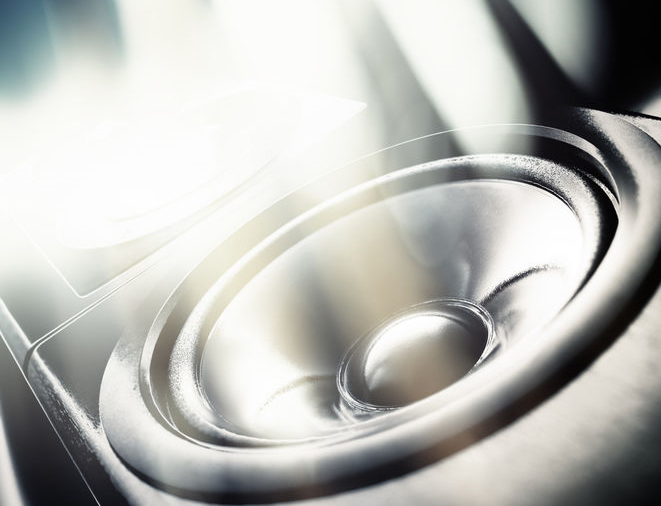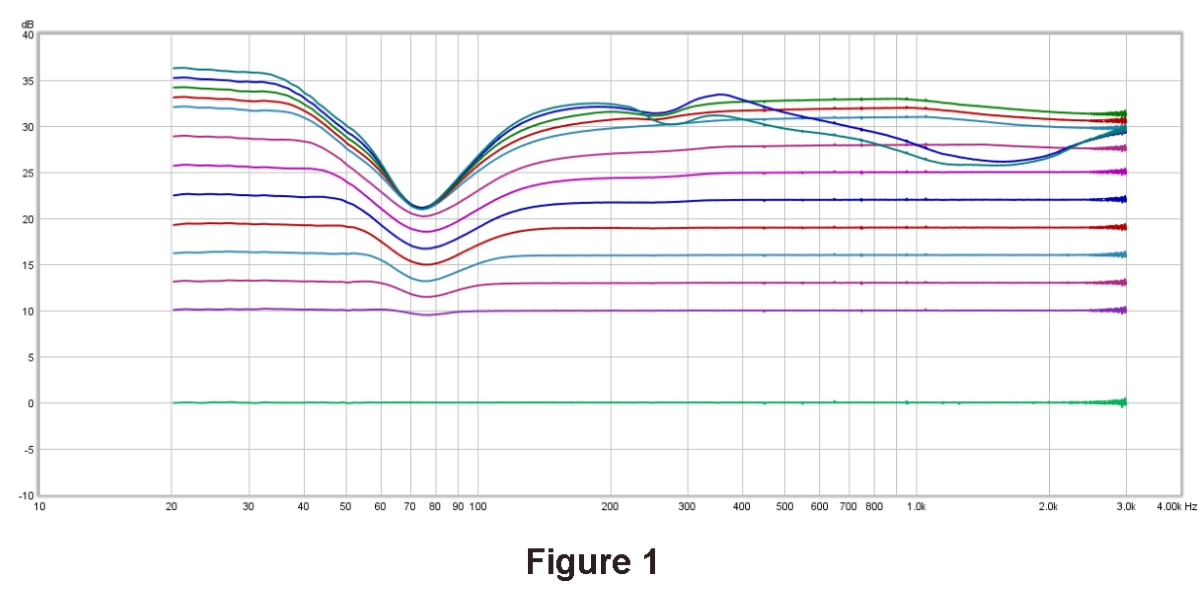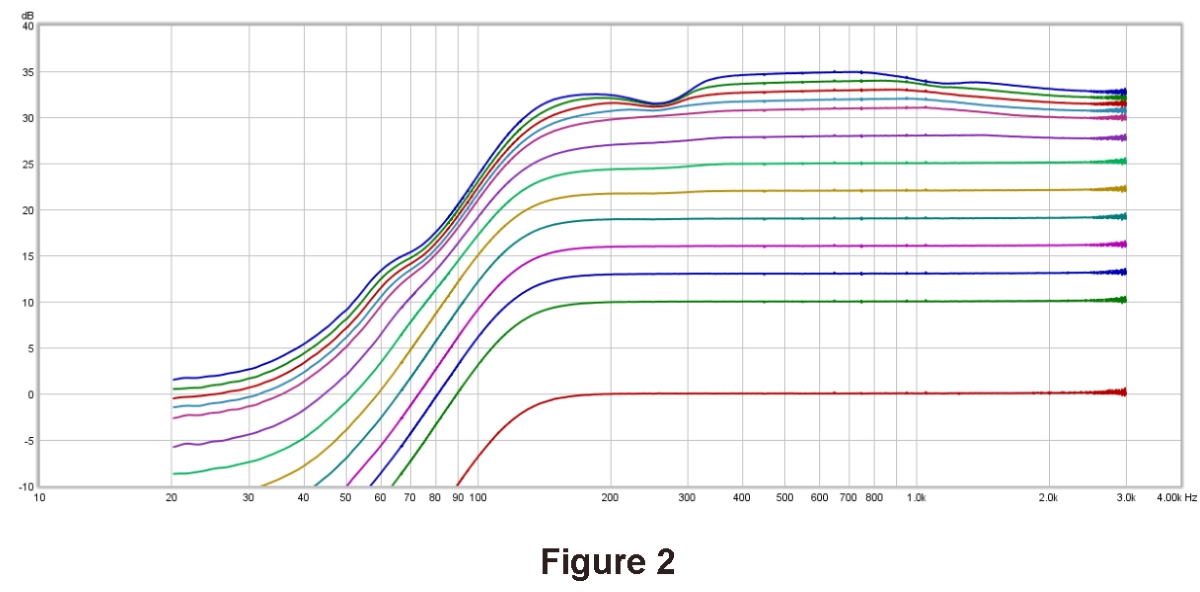In “Spec Wars,” I analyzed the industry-standard “maximum sound pressure level” (max SPL) rating, which is a single number that’s simply supposed to tell us the maximum loudness of a given loudspeaker.
It does achieve that, but in a way that’s so far removed from how we actually use loudspeakers that the specification itself is all but pointless. We might as well drop loudspeakers out of airplanes and see how loud the sound is when they hit the ground.
This time we’re going to build on the previous article by finding the limits of some real-world commercial loudspeakers and then use that information to suggest a useful set of specifications for those products.
Test Signals
Before diving in, it’s important to consider the program material that will be presented to the loudspeakers under test. One of the most demanding test signals is a sine wave. A little way above the bottom tuning frequency, the cone transducer’s motion reaches a maximum, and this is usually where a loudspeaker will first show its limits. As a result, that’s the method that will be used – a sine wave at a frequency selected to give the loudspeaker maximum difficulty.
Music is made up of many frequencies coming and going, so it’s entirely possible that a loudspeaker specified with worst-case sine waves will be able to produce higher SPL by carefully choosing the program material. Given that, the specifications that will be derived here will be similar to those used for the old iron touring amplifiers: “All units shall meet or exceed these minimum specifications.”
In practice, this means that some program material will go a few decibels (dB) louder than the rating would suggest, but even giving the loudspeaker the most difficult time possible will still result in the specified SPL being met. Currently, there aren’t many professionals that seriously believe in peak SPL ratings, and that’s quite sad: We’ve played the marketing game so hard that the numbers are almost meaningless. Here’s an opportunity to change that.
Case 1 – Passive Loudspeaker
First up is a test of an older, passive 12-inch/2-way loudspeaker. The manufacturer does not specify a maximum SPL, but does suggest a sensitivity of 98 dB at 1 watt (1 w) input, and a program power rating of 700 watts. In theory that should result in max SPL of 126.5 dB.
This loudspeaker has a reasonably heavy-duty compression driver and a crossover point around 3 kHz, so it’s fair to assume that the 12-inch cone driver will be the first to show signs of stress with normal program material. Following a quick look at the impedance curve, the port tuning is confirmed as 60 Hz, and the cabinet volume is about 40 liters (about 1.4 cubic feet) internally.
This is enough information to load the cone driver into a simulation program and see what’s going on. The driver has a fairly generous 5.5 mm (.22 inch) of one-way linear cone excursion, and so it can produce a useful amount of low end: 121 dB at 84 Hz, with a little more than 200 watts input.
Compared with the active loudspeaker we’ll be looking at next, the 5.5 dB shortage isn’t too bad. However, feed it with a power amplifier capable of the recommended 700 watts, combined with program material with a lot of energy centered on/around 85 Hz, and this driver wouldn’t last long, as it would attempt to move 10 mm one way – just under twice the rated travel. So let’s give this loudspeaker a subwoofer to play with, relieving the 12-inch cone driver of the heavy lifting involved in producing low-frequency signals in addition to providing more headroom.
The most often-seen active crossover in live sound is the 4th-order Linkwitz-Riley crossover. It’s useful for a variety of reasons, including that it sums flat and the low-pass and high-pass sections are in phase. With such a crossover in place at 100 Hz, our cone driver does quite well – even with the full 700 watts of input, excursion only reaches 5 mm at around 115 Hz. Chances are, then, that it will still sound good even with that amount of power being pumped in. The simulation program also shows that it will be producing 126 dB above the crossover frequency.
As a result, for this particular loudspeaker we can say yes, it will achieve peaks of 126 dB and it should still sound pretty good, but only when accompanied by a subwoofer. Running down to 60 Hz, 121 dB peaks would be possible.
Evaluating passive loudspeakers in this manner is relatively easy, but active loudspeakers are another story. They have a lot of signal processing that can add things like frequency-dependent compressors that will prevent mechanical damage while eking out every bit of SPL possible.
Case 2 – Active Loudspeaker
Our next test model is a 10-inch/2-way loudspeaker with a stated 700 watts of “peak” power, or 325 watts continuous. It claims 129 dB max SPL and a frequency range of 55 Hz to 20 kHz (-10 dB). This loudspeaker was chosen for a few reasons: it has plenty of DSP available; it’s reasonably cheap; I happened to have one immediately to hand (and I’m not emotionally attached to it); and it’s pretty much the perfect candidate for the sort of specifications that are widespread.
Before testing, I ran a quick simulation of a top-end 10-inch loudspeaker in a similar cabinet. To achieve about 129 dB, the cone excursion required was slightly over 20 mm one way, beyond Xmech (the mechanical limit of a cone’s travel) of the unit in question. We already know, then, that our test loudspeaker won’t produce 129 dB over its entire bandwidth.
In the interest of my own sanity, I disconnected the drive units and connected a load bank of the correct resistance. The amplifier output signal was measured so that all of the loudspeaker’s onboard DSP trickery could be graphed.
The first set of frequency sweeps produced interesting results. With the loudspeaker set up for front-of-house use, there was approximately 12 dB of boost towards the low-frequency region, peaking around 67 Hz. In order to compensate for any EQ that was being used, the initial sweep was used to calibrate the loudspeaker so that a low-power sweep would show as a linear response, and any deviations from that would be very obvious as the power level was increased.
With each test, a series of sweeps were performed, starting at low power and working up until the “limit” light was on continuously throughout the sweep, indicating there was no more power available. It’s worth noting that the software used starts the sweep at a low frequency and goes upwards.
Figure 1 shows the outcome. Starting at the bottom line at 0 dB for a flat response, power was increased by 10 dB, resulting in a little wiggle around 75 Hz – a sign of things to come. With that threshold found, the power level was increased in 3 dB increments (a doubling of output power) until it was deemed best to continue with 1 dB increments.
Digging a bit deeper, we can see there’s a gradual onset of compression around 75 Hz as power increases, until some limit is found, where the level increases result in zero level difference at 75 Hz. It’s also worth noting that the “limit” light only engaged for the final two sweeps, where the output drops above a few hundred hertz as the RMS (Root-Mean-Square, the effective value of the total waveform) limiters start to clamp down in order to save the 10-inch cone driver from long-term thermal abuse.
Also on the subject of the “limit” light, there’s a difference of about 24 dB from the first sign of compression in the bass to when the cabinet announces that it’s engaging the limiters. That’s a really big discrepancy – there’s an 11 dB difference from when the bass is hard limiting and when the red light comes on!
Clearly, when fed a full-range music signal, there’s going to be a distinct lack of bass well before the red light fires up. As we tried with the first test speaker, filtering out the bass for a dedicated subwoofer might help matters.
This particular loudspeaker has a switch that engages a 120 Hz high-pass filter, so let’s try that. Figure 2 shows that the situation has improved. There’s a little compression below 200 Hz as the power levels go up, but nowhere near as drastic as with full-range operation.
A brief test of the high-frequency section (compression driver) indicates that, as suspected, the 10-inch cone driver is the limiting factor in this cabinet: the high-frequency amplifier does show the onset of limiting when driven hard but the mid-bass amplifier is very far into limiting by that point. No further tests were conducted on the high-frequency section.
So, what’s the verdict? We have a loudspeaker that, when played full-range, will show signs of compression in the bass quite early on, but when a subwoofer is used, can provide quite a lot more output. You could say that this loudspeaker would be fine with acoustic artists or when used with a subwoofer, but it’ll show it’s limitations quickly when used stand-alone by DJs or bands.
Results
Clearly, two specifications are needed to describe the performance of these types of loudspeakers. The first specification would be full-range signals, with the loudspeaker being asked to reproduce the full spectrum.
The second specification would be with the high-pass filter engaged to represent how loud the loudspeaker can go either with subwoofers or with program material that does not demand low-frequency reinforcement. Since the maximum SPL achievable by a loudspeaker is usually limited by the low-frequency driver, removing some of the demands on that driver ought to result in higher SPL.
Let’s derive those specifications for the active loudspeaker. First, the full-range signal. At the onset of limiting, the amplifier puts out around 30 volts RMS, which translates to around 250 watts for a driver that’s 4ohm nominally. By taking the Thiele-Small parameters for that particular drive unit, a good simulation of the loudspeaker can be set up. At maximum power, with no processing in the bass, cone excursion would exceed 7 mm one way. That doesn’t sound like a lot, but only the best 10-inch cone drivers can manage that, and the 10” driver used here is not in that category.. Most get to around half that figure before they go non-linear.
After the fairly gentle compression, there’s a hard limit in the bass that’s 11 dB below the maximum output; 11 dB below 30 volts input gives us 8.5 volts input, which results in the driver moving a little more than 2 mm one-way. The driver would certainly be acting linearly at this point, and if anything, the limiter might be set a little conservatively.
Because the limiting in the bass happens earliest at 75 Hz, the SPL measurement must be taken from there. In this case, the SPL is 106 dB. That’s how loud this loudspeaker will go when fed with a 75 Hz sine wave. It will go louder at other frequencies, though, where the DSP isn’t limiting the output so ferociously.
Next up, the high-passed signal. Looking at the graphs, the high-pass filter is a 3rd-order Butterworth with a -3 dB point at 120 Hz. There’s a little compression below 200 Hz, taking off about 5 dB as we approach the limiters. With the filter and compression in place, cone excursion reaches 2.5 mm one way at 125 Hz. The loudspeaker will be producing 113 dB at 125 Hz. Consider, for a moment, that the manufacturer claims that this unit will produce 129 dB.
In a more formal manner, the way the specifications have been derived is this:
— Find the point with earliest compression/limiting.
— Subject the drive unit to a signal at the worst-case frequency – the one where the limiter kicks in earliest. For our active loudspeaker under test, it was 75 Hz.
— Record the SPL produced at that frequency. In this case, a simulation was used in the absence of an anechoic chamber.
— Record the frequency range of the loudspeaker. This is very important – a product that’s very loud but only reaches down to 90 Hz might not be as useful as something that’ll go flat down to 50 Hz. Quote the -10 dB point for full-range use or the crossover frequency for use with subwoofers.
For our active loudspeaker, the specifications should be expressed as follows:
Full-Range SPL – 106 dB (55 Hz-20 kHz, -10 dB)
Mid-High SPL – 113 dB (120 Hz filter engaged)
And here’s the same for our passive loudspeaker:
Full-Range SPL – 121 dB (45 Hz-20 kHz, -10 dB)
Mid-High SPL – 126 dB (4th-order Linkwitz-Riley filter at 100 Hz)
Recommended Amplifier Power – 700 watts into 8 ohms.
Conclusion
These numbers are perfectly attainable by these loudspeakers, and it’s likely that they’ll sound reasonably good when driven with music at those levels. That makes it an extremely useful specification, similar to the ones given to older touring amplifiers: “All units shall meet or exceed these minimum ratings.” One can be confident that those amplifiers would always give out at least that much power.
In the case of the active loudspeaker, with full-range program material, it’ll do 106 dB and sound reasonably good doing it. Not feeding it bass, it’ll put out 113 dB, and again, sound reasonably good doing it.
To reiterate part of my previous article on this topic – as an industry, we’re having to make do with hearsay and quick demos in less-than-ideal conditions to help us choose products because the specifications we’re being presented with aren’t based on anything useful. We should do better.
To those of you putting the numbers on the brochures, boxes, banners, and any other sales materials, consider this: products ought to be sold because they’re good at what they’re designed to do. If they really are the best, then sensibly derived numbers will still be ahead of the competition.

















